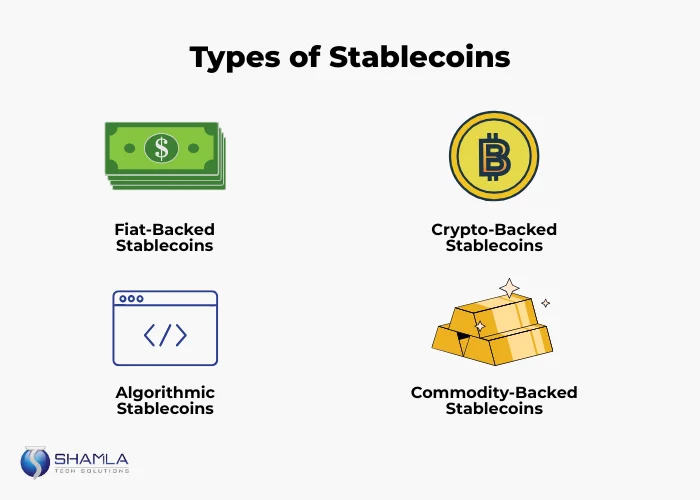Stablecoins are digital coins that keep their value steady even when other cryptocurrencies jump up and down. Stablecoins come in four main types:
- Fiat-backed stablecoins
- Crypto-backed stablecoins
- Algorithmic stablecoins
- Commodity-backed stablecoins
Understanding the types of stablecoins, their classification of stablecoins, and options for stablecoin development is key for anyone exploring crypto stability. In this post, you’ll learn what makes each type work, see real-world examples, and discover why stablecoins are vital to today’s market.
What Are Stablecoins?
A stablecoin is a form of digital currency created to keep its price steady, often tied to a real-world asset like fiat money or controlled by a set of programmed rules.
Stablecoins mirror a traditional asset’s price, like the US dollar or gold, so their value does not swing wildly. They let you use crypto for payments, trading, or holding value without risking a sudden drop.
Most people choose stablecoins because they need a safe place to park funds during market volatility. While Bitcoin or Ethereum can move 10-20% in a day, stablecoins stay close to $1 (or another asset price).
Key features of stablecoins include:
- Low volatility – their value barely changes in the short term.
- Easy usability – you can send or receive them like any other token.
- Clear backing – they usually link to real assets or strict code.
For those seeking a trusted option, whether a developer offering stablecoin development services or an investor looking into stablecoin development, understanding the types of stablecoins and their classification of stablecoins is crucial.
The 4 Types of Stablecoins with Examples
1. Fiat-Backed Stablecoins
Fiat-backed stablecoins are cryptocurrencies that match the value of a traditional currency, such as the US dollar, on a one-to-one basis.
How They Work:
- A company keeps $1 in a real bank account for every 1 stablecoin in circulation.
- Users send fiat to the issuer, who mints new tokens. When users return tokens, the issuer sends back fiat and burns the tokens.
- Regular audits or proofs (sometimes third-party reports) verify that reserves match tokens
Examples of Fiat-Backed Stablecoins:
- USDT (Tether)
- USDC (USD Coin)
- BUSD (Binance USD)
2. Crypto-Backed Stablecoins
Crypto-backed stablecoins rely on other cryptocurrencies, commonly Ethereum, to secure their value. They keep a higher collateral value than the issued amount to absorb market swings.
Mechanism:
- Users deposit cryptocurrency like ETH into a smart contract as collateral.
- The contract mints stablecoins at a ratio (e.g., $150 worth of ETH for $100 in stablecoins).
- If crypto’s price drops too much, the contract sells collateral to cover the stablecoins.
Examples of Crypto-Backed Stablecoins:
- DAI (by MakerDAO)
- sUSD (Synthetix USD)
3. Algorithmic Stablecoins
Algorithmic stablecoins use code to adjust supply. When price rises, smart contracts mint more coins; when price drops, they burn coins or offer bonds to reduce supply.
How Algorithms Control Supply
- A set of rules (algorithm) checks the stablecoin price against its peg (e.g., $1).
- If price > $1 → mint new coins and sell on the market to push the price down.
- If price < $1 → buy coins back or issue bonds that let holders redeem later at higher value.
Examples of Algorithmic Stablecoins:
- FRAX (partially collateralized, partially algorithmic)
- UST (TerraUSD, now defunct, its failure highlights risks)
Risk Callout: Algorithmic models can break if demand suddenly falls or if large holders manipulate price. Always check collateral mechanisms and code audits.
4. Commodity-Backed Stablecoins
Commodity-backed stablecoins represent a claim on a real asset like gold, oil, or silver. Every token stands for a specific quantity of the real-world asset it’s backed by.
How it is Linked to Real-World Assets:
- Issuers keep gold or other backing assets securely stored in vaults.
- For every coin issued, there is a certificate or proof of ownership of a physical amount (e.g., 1 gram of gold).
- Audits and insurance ensure the underlying assets exist and are secure.
Examples of Commodity-Backed Stablecoins:
- PAXG (Pax Gold) – This stablecoin is backed by one troy ounce of physical gold.
- XAUT (Tether Gold)
How Do Stablecoins Maintain Their Stability?
Stablecoins maintain their stability by following specific rules or holding real assets that keep their price close to the peg.
The three main mechanisms that help Stablecoins maintain their stability include:
- Reserve-backed (fiat assets kept in bank accounts to match circulating tokens)
- Over-collateralized (crypto assets are locked in smart contracts at a value higher than the amount of stablecoins issued)
- Algorithmic (code adjusts supply automatically based on market price)
By using these methods, each stablecoin model follows strict rules or holds real assets to stay near a fixed price. Compliance with stablecoin regulation also ensures trust.
Use Cases of Stablecoins
1. Trading
2. Payments
3. Remittances
4. DeFi Lending & Borrowing
Stablecoins are key for lending and borrowing on decentralized platforms. Users deposit stablecoins as collateral to borrow other tokens, or they lend tokens to earn interest. This lowers risk because the borrowed asset remains near a fixed value. Platforms use smart contracts to automatically handle loans, reducing manual steps. In stablecoin use cases like DeFi payments, borrowers pay stablecoin interest, which stays predictable. Understanding the types of stablecoins helps lenders choose coins with reliable backing, minimizing risks in smart contracts.
5. Yield Farming & Liquidity Provision
Why Stablecoins Matter in Today’s Crypto Economy
1. Price Stability
- Benefits: Traders avoid wild swings by switching to stablecoins when markets dip.
- Impact: Reduces panic selling, maintains market confidence.
2. Financial Bridge
- Benefits: In areas where local currencies are unstable, people can preserve their wealth by using stablecoins.
- Impact: Encourages financial inclusion and access to global markets.
3. Liquidity & Adoption
- Benefits: Exchanges rely on stablecoins to offer trading pairs for almost every token.
- Impact: Boosts speed of transactions and reduces reliance on banking rails.
Key Benefits of Stablecoins:
- Cost-Effective Transfers: Moving stablecoins often costs just pennies in network fees.
- Fast Settlements: Transactions clear in minutes.
- Global Reach: Anyone can send or receive stablecoins without bank accounts.
Looking Ahead: As stablecoin adoption grows, businesses and individuals will find more uses – like payroll in stablecoins or paying for services instantly.
To drive growth, companies should explore how to create a stablecoin and the cost of stablecoin development. Whether you want to build or integrate stablecoins, knowing the types of stablecoins and their categories of stablecoins helps you choose the right approach.
The Future of Stablecoins
Develop Stablecoins with Shamla Tech
At Shamla Tech, we help you build stablecoins that meet high standards for security and stability. As a top stablecoin development company, we offer:
- Consulting on types of stablecoins – Choose the right model for your goals.
- Smart contract design – Secure and audited code for trust.
- Reserve management tools – Automated systems to track fiat or crypto collateral.
- Regulatory compliance – Guidance on local rules and reporting.
Our stablecoin development services cover tailored audits, launch assistance, and continuous upkeep.
Conclusion
In this guide, you learned about the types of stablecoins, their uses, and how they keep value steady. From fiat-backed to algorithmic models, each category has its own trade-offs. For startups or established firms, partnering with a top stablecoin development company like Shamla Tech ensures you navigate technical and regulatory hurdles smoothly.
Understanding the classification of stablecoins and tapping into expert stablecoin development services are steps toward reliable crypto solutions.
Ready to launch your own Stablecoin?
Contact Us for a free quote and start building the type of Stablecoin that fits your needs!






